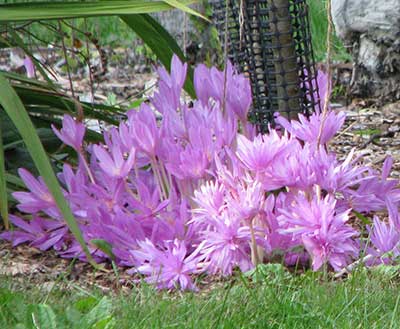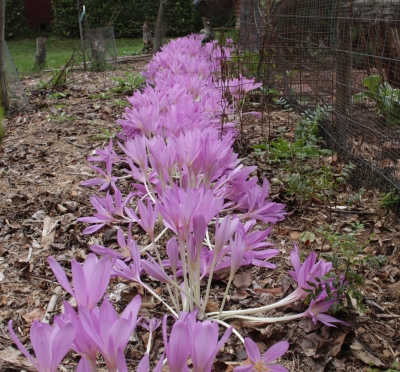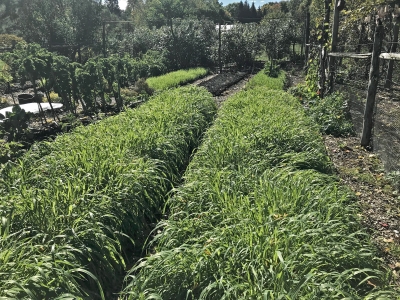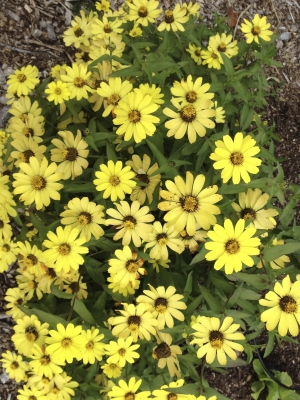Colorful, Sometimes Tasty, Ground
Lurid Ground
Lurid, violet flowers have sprouted in the wood chip mulch beneath my row of dwarf pear trees. The flowers are autumn crocuses, the first part of the two-part flowery show that takes place each autumn in that piece of ground.

The second part of that flowery show, soon to follow, will be autumn crocuses. “But,” you exclaim, “autumn crocuses were the first part of the show!” Let me explain.
This first show is from a flower called autumn crocus but which is botanically a Colchicum species. It’s not really a crocus, not even related. Colchicum flowers resemble true crocus flowers, on steroids. The second show will be from true crocuses (that is, Crocus species) that happen to bloom in autumn. The Crocus autumn crocuses are dainty and in colors like our spring crocuses.
What’s really unique about the colchicum flowers, and what makes them so striking, is that, first, they emerge from the soil this time of year, and second, that they do so without any leaves, making the contrast between the mulched ground and the flowers all the more dramatic. The color itself is dramatic, the row of bold-colored blossoms painting a wide swath along the ground.

Cochicums, like every other plant, need to photosynthesize, and, like every other plant, need leaves to do so. Those leaves, which are wide, long, and fairly large, appear for awhile in spring and look nothing like true crocus leaves. Not only do the plants not need leaves in autumn, they also don’t need soil. Colchicum bulbs will sprout their lurid violet flowers even if just left sitting on a bench or table!
Green Tastes Good
Aside from spots of bright color, the dominant color in my garden is green. That verdure is especially evident in my vegetable garden, now in its autumn glory – lush and green – and becoming more so every day. I’ve been sowing and planting with almost the same fervor as in spring.

Bed of lettuce and chinese cabbage
A few weeks ago I made my last planting of outdoor lettuce, using transplants that had been growing in seed flats for about a month. The varying textures and colors of the different varieties make a pretty tapestry on the ground, so pretty that it seems almost a shame to pick any of the tender, tasty heads and ruin the picture. I’m not sure how large they’ll grow before stopped or turned to mush by really cold weather. Protection beneath a tunnel of clear plastic with, later, an additional covering of some spun-bonded row cover material, should keep them and me happy into December.
Other beds display yet more shades of green with varying textures. There’s a bed of kale, which has been pumping out deep green leaves for good eating since spring. Another bed has endive – Broad-Leaved Batavian — planted close enough so neighboring plants push each other’s leaves over the loosely forming heads. Shaded from sunlight, those inner leaves become tender and sweet, livened up with just a hint of bitterness.
Green, Not for Eating
Lushest green of all beds in my garden are those that are sprouting oats. Yes, that’s the same oats that we (and horses) eat, except that I didn’t plant these oats for eating. I plant oats as so-called cover crops, which are plants grown to improve and protect the soil.
I can only eat just so much lettuce, endive, kale, and other greens. If I’ve filled this quota for planting and no longer have further use for every bed this season, I plant it with oats. September 30th is my deadline because after this date — here in the lower Hudson Valley, at least — days are too short and weather becomes too cold to expect much growth.

Oats, just one of a number of potential cover crops, thrive in the cool weather of autumn and early winter. Their roots, pushing through the soil, crumble it and latch onto nutrients that might otherwise wash down below the root zone. After the roots die, they enrich the soil with humus and leave behind channels through which air and water can move within the soil. Above ground, the stems and leaves protect the soil surface from being washed around by pounding raindrops.
Most of all, I like the look of that green carpet of grassy oat leaves. Both I and Mother Nature abhor bare ground, which becomes subject to wind and water erosion, and large swings in temperatures through the year.



